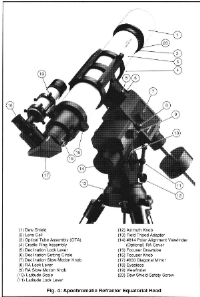 |
| Part | Function |
|---|---|
| Objective Lens | |
| Eyepiece | |
| Focus Knob | |
| Tube | |
| Viewfinder | |
| Fine-Adjustment Knobs | |
| Lock Levers |
 |
- What is the focal length (fobj ) of the objective lens of the telescope?
- What is the focal length (feye) of the eyepiece of the telescope?
- What is the magnification of this telescope using this eyepiece?
-
magnification = fobj/feye =
- What would be the magnification of the refracting telescope if you used an eyepiece with feye = 10 mm?
-
magnification =
- In words, summarize how we determine the magnification of a telescope.
-
Example: D1 = 10 cm, D2 = 200 cm
Ratio = 2002/102 = 400. That is, the larger telescope is 20 times as large, but has 400 times the light gathering power.
The 8-meter Keck telescope in Hawaii is one of the largest in the world.
Compare its light gathering power to our telescope (make sure you use the
same units for all quantities -- 1 meter = 100 centimeters).
